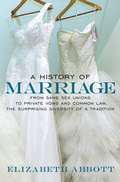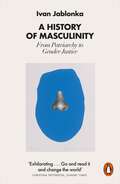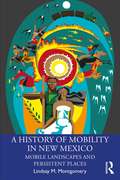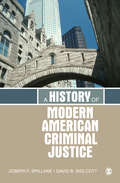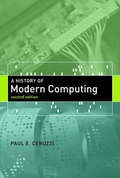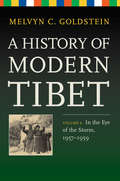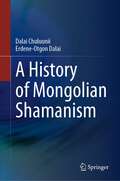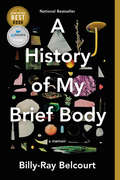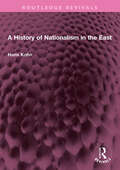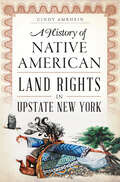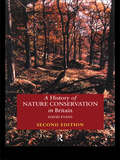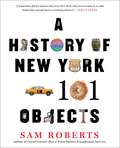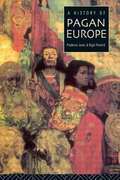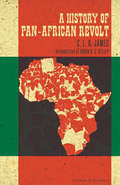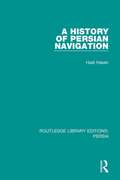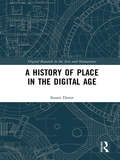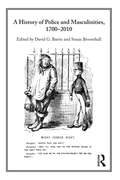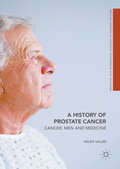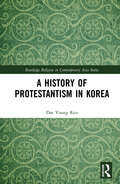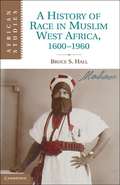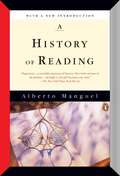- Table View
- List View
A History of Marriage: From Same Sex Unions to Private Vows and Common Law, the Surprising Diversity of a Tradition
by Elizabeth AbbottWhat does the "tradition of marriage" really look like? In A History of Marriage, Elizabeth Abbott paints an often surprising picture of this most public, yet most intimate, institution. Ritual of romance, or social obligation? Eternal bliss, or cult of domesticity? Abbott reveals a complex tradition that includes same-sex unions, arranged marriages, dowries, self-marriages, and child brides. Marriage--in all its loving, unloving, decadent, and impoverished manifestations--is revealed here through Abbott's infectious curiosity.
A History of Masculinity: From Patriarchy to Gender Justice
by Ivan Jablonka'Exhilarating . . . a work of scholarship, but also inspiration. . . Go and read Jablonka and change the world' Christina Patterson, Sunday Times'An unexpected bestseller in France. . . it has sparked conversations' ChallengesA highly acclaimed, bestselling work from one of France's preeminent historiansWhat does it mean to be a good man? To be a good father, or a good partner? A good brother, or a good friend? In this insightful analysis, social historian Ivan Jablonka offers a re-examination of the patriarchy and its impact on men. Ranging widely across cultures, from Mesopotamia to Confucianism to Christianity to the revolutions of the eighteenth century, Jablonka uncovers the origins of our patriarchal societies. He then offers an updated model of masculinity based on a theory of gender justice which aims for a redistribution of gender, just as social justice demands the redistribution of wealth. Arguing that it is high time for men to be as involved in gender justice as women, Jablonka shows that in order to build a more equal and respectful society, we must gain a deeper understanding of the structure of patriarchy - and reframe the conversation so that men define themselves by the rights of women. Widely acclaimed in France, this is an important work from a major thinker.
A History of Mobility in New Mexico: Mobile Landscapes and Persistent Places
by Lindsay M. MontgomeryA History of Mobility in New Mexico uses the often-enigmatic chipped stone assemblages of the Taos Plateau to chart patterns of historical mobility in northern New Mexico. Drawing on evidence of spatial patterning and geochemical analyses of stone tools across archaeological landscapes, the book examines the distinctive mobile modalities of different human communities, documenting evolving logics of mobility—residential, logistical, pastoral, and settler colonial. In particular, it focuses on the diversity of ways that Indigenous peoples have used and moved across the Plateau landscape from deep time into the present. The analysis of Indigenous movement patterns is grounded in critical Indigenous philosophy, which applies core principles within Indigenous thought to the archaeological record in order to challenge conventional understandings of occupation, use, and abandonment. Providing an Indigenizing approach to archaeological research and new evidence for the long-term use of specific landscape features, A History of Mobility in New Mexico presents an innovative approach to human-environment interaction for readers and scholars of North American history.
A History of Modern American Criminal Justice
by Joseph F. Spillane Dr David B. WolcottIn A History of Modern Criminal Justice, authors Joseph Spillane and David Wolcott focus on the modern aspects of the subject, from 1900 to the present. A unique thematic rather than a chronological approach sets this book apart from the competition, with chapters organized around themes such as policing, courts, due process, and prison and punishment. Making connections between history and contemporary criminal justice systems, structures and processes, A History of Modern Criminal Justice offers students the latest in historical scholarship, made relevant to their needs as future practitioners in the field. This book is appropriate for any course on the history of criminal justice.
A History of Modern Computing, second edition (History of Computing)
by Paul E. CeruzziFrom the first digital computer to the dot-com crash—a story of individuals, institutions, and the forces that led to a series of dramatic transformations.This engaging history covers modern computing from the development of the first electronic digital computer through the dot-com crash. The author concentrates on five key moments of transition: the transformation of the computer in the late 1940s from a specialized scientific instrument to a commercial product; the emergence of small systems in the late 1960s; the beginning of personal computing in the 1970s; the spread of networking after 1985; and, in a chapter written for this edition, the period 1995-2001. The new material focuses on the Microsoft antitrust suit, the rise and fall of the dot-coms, and the advent of open source software, particularly Linux. Within the chronological narrative, the book traces several overlapping threads: the evolution of the computer's internal design; the effect of economic trends and the Cold War; the long-term role of IBM as a player and as a target for upstart entrepreneurs; the growth of software from a hidden element to a major character in the story of computing; and the recurring issue of the place of information and computing in a democratic society. The focus is on the United States (though Europe and Japan enter the story at crucial points), on computing per se rather than on applications such as artificial intelligence, and on systems that were sold commercially and installed in quantities.
A History of Modern Tibet, Volume 4: In the Eye of the Storm, 1957-1959
by Melvyn C. GoldsteinIt is not possible to understand contemporary politics between China and the Dalai Lama without understanding what happened in the 1950s, especially the events that occurred in 1957–59. The fourth volume of Melvyn C. Goldstein's History of Modern Tibet series, In the Eye of the Storm, provides new perspectives on Sino-Tibetan history during the period leading to the Tibetan Uprising of 1959. The volume also reassesses issues that have been widely misunderstood as well as stereotypes and misrepresentations in the popular realm and in academic literature (such as in Mao’s policies on Tibet). Volume 4 draws on important new Chinese government documents, published and unpublished memoirs, new biographies, and a large corpus of in-depth, specially collected political interviews to reexamine the events that produced the March 10th uprising and the demise of Tibet’s famous Buddhist civilization. The result is a heavily documented analysis that presents a nuanced and balanced account of the principal players and their policies during the critical final two years of Sino-Tibetan relations under the Seventeen-Point Agreement of 1951.
A History of Mongolian Shamanism
by Dalai Chuluunii Erdene-Otgon DalaiThis book discusses the evolution of Mongolian shamanism from the distant past to the collapse of great empires such as the Yuan Dynasty in the fourteenth century, drawing on archeological findings and historical resources like the Mongolian Secret History. Further, it introduces readers to the cultural and ideological differences between Mongolian shamanists, who believe in the Eternal Blue Sky, and modern Mongols, who follow Buddhist teachings. In closing, the authors put forward the idea that Mongolian shamanism could have helped build great empires, emphasizing, e.g., shamanism’s influence on Mongolian culture and literature in the Middle Ages.
A History of My Brief Body
by Billy-Ray BelcourtThe youngest ever winner of the Griffin Prize mines his own personal history to reconcile the world he was born into with the world that could be.Billy-Ray Belcourt's debut memoir opens with a tender letter to his kokum and memories of his early life in the hamlet of Joussard, Alberta, and on the Driftpile First Nation. From there, it expands to encompass the big and broken world around him, in all its complexity and contradictions: a legacy of colonial violence and the joy that flourishes in spite of it, first loves and first loves lost, sexual exploration and intimacy, and the act of writing as a survival instinct and a way to grieve. What emerges is not only a profound meditation on memory, gender, anger, shame, and ecstasy, but also the outline of a way forward. With startling honesty, and in a voice distinctly and assuredly his own, Belcourt situates his life experiences within a constellation of seminal queer texts, among which this book is sure to earn its place. Eye-opening, intensely emotional, and excessively quotable, A History of My Brief Body demonstrates over and over again the power of words to both devastate and console us.
A History of Nationalism in the East (Routledge Revivals)
by Hans KohnFirst published in 1929, A History of Nationalism in the East brings together in one truly fascinating volume a mass of information hitherto scattered and partly unavailable. Hans Kohn sums up the general situation in his Introduction. He tells us that the World War I produced three great communities of interest, distinct and, to some extent, mutually antagonistic. The first was that of the continent of Europe, barring Russia, which was faced with the necessity for the gradual breaking down of national boundaries, for political, financial, and economic reasons. The second was that of the Anglo-Saxon people, the United States, Great Britain, Canada, Australia, and South Africa. This had to face Soviet Russia on the one hand, and the Oriental, the third, community of interests on the other. Here he sketches suggestively the development of the nationalist movement in Islam, India, Egypt, Turkey, Arabia, and Persia. The language used is a reflection of its era and no offence is meant by the Publishers to any reader by this republication. This book will be of interest to students of history, political science, international relations, and geography.
A History of Native American Land Rights in Upstate New York
by Cindy AmrheinA complex and troubled history defines the borders of upstate New York beyond the physical boundaries of its rivers and lakes. The United States and the state were often deceptive in their territory negotiations with the Iroquois Six Nations. Amidst the growing quest for more land among settlers and then fledgling Americans, the Indian nations attempted to maintain their autonomy. Yet state land continued to encroach the Six Nations. Local historian Cindy Amrhein takes a close and critical view of these transactions. Evidence of dubious deals, bribes, faulty surveys and coerced signatures may help explain why many of the Nations now feel they were cheated out of their territory.
A History of Nature Conservation in Britain
by David EvansOur attitudes towards `nature' and the countryside are fickle. The conservation movement, despite enjoying its highest membership ever, has achieved only limited success over the last one hundred years of campaigning. Can conservationists now shake off their insular, disunited and negative image so as to gain the influence that the size of their movement warrants? A History of Nature Conservation in Britain traces the rise of the conservation movement from its beginnings in Victorian coffee houses to today's societies with their membership numbering in the millions. The first complete history of the British, and oldest, branch of the movement, David Evans's book offers invaluable insights into the campaigns for countryside protection and access, from battles against the use of pesticides, against pollution and genetic engineering through to legislation for the protection of our wildlife and the freedom to walk the mountains. The 2nd Edition has been fully revised and updated. Topical issues are considered afresh; and new chapters reflect the rapid changes throughout the 1990s both in social attitudes, conservation practices, legislation, funding and within conservation organizations themselves. In the light of recent developments, Evans also looks at some difficult choices to be made in years ahead and asks how the conservation movement will fare on the new global stage.
A History of New York in 101 Objects
by Sam Roberts“Delightfully surprising….A portable virtual museum…an entertaining stroll through the history of one of the world’s great cities” (Kirkus Reviews), told through 101 distinctive objects that span the history of New York, almost all reproduced in luscious, full color.Inspired by A History of the World in 100 Objects, Sam Roberts of The New York Times chose fifty objects that embody the narrative of New York for a feature article in the paper. Many more suggestions came from readers, and so Roberts has expanded the list to 101. Here are just a few of what this keepsake volume offers: -The Flushing Remonstrance, a 1657 petition for religious freedom that was a precursor to the First Amendment to the Constitution. -Beads from the African Burial Ground, 1700s. Slavery was legal in New York until 1827, although many free blacks lived in the city. The African Burial Ground closed in 1792 and was only recently rediscovered. -The bagel, early 1900s. The quintessential and undisputed New York food (excepting perhaps the pizza). -The Automat vending machine, 1912. Put a nickel in the slot and get a cup of coffee or a piece of pie. It was the early twentieth century version of fast food. -The “I Love NY” logo designed by Milton Glaser in 1977 for a campaign to increase tourism. Along with Saul Steinberg’s famous New Yorker cover depicting a New Yorker’s view of the world, it was perhaps the most famous and most frequently reproduced graphic symbol of the time. Unique, sometimes whimsical, always important, A History of New York in 101 Objects is a beautiful chronicle of the remarkable history of the Big Apple. “The story [Sam Roberts] is telling is that of New York, and he nails it” (Daily News, New York).
A History of Pagan Europe
by Nigel Pennick Prudence JonesThe book is the definitive study of the indigenous religions of Europe and their practices, beliefs and customs. The authors divide Europe into five broad cultural areas and trace the expression and development of Pagan religion in each of them from earliest times to present day. From the serpent goddesses of ancient Crete to modern nature worship and the restoration of the indigenous religions of Eastern Europe, the wide-ranging book offers a provocative new perspective of European history.
A History of Pan-African Revolt (The Charles H. Kerr Library)
by Robin D. G. Kelley C. L. R. JamesOriginally published in England in 1938 and expanded in 1969, this work remains the classic account of global Black resistance. This concise, accessible history of revolts by African peoples worldwide explores the wide range of methods used by Africans to resist oppression and the negative effects of imperialism and colonization as viewed in the 20th century. Written from a radical perspective with a substantial new introduction that contextualizes the work in the ferment of the times, A History of Pan-African Revolt is essential to understanding liberation movements in Africa and the diaspora and continues to reveal new insights, lessons, and visions to successive generations.
A History of Persian Navigation (Routledge Library Editions: Persia #3)
by Hadi HasanThis book, first published in 1928, is based on Chinese, Persian and Arabic sources, and provides the first scholarly account of the history of Persian maritime exploration.
A History of Place in the Digital Age (Digital Research in the Arts and Humanities)
by Stuart DunnA History of Place in the Digital Age explores the history and impact of Geographic Information Systems (GIS) and related digital mapping technologies in humanities research. Providing a historical and methodological discussion of place in the most important primary materials which make up the human record, including text and artefacts, the book explains how these materials frame, form and communicate location in the age of the internet. This leads in to a discussion of how the World Wide Web distorts and skews place, amplifying some voices and reducing others. Drawing on several connected case studies from the early modern period to the present day, the spatial writings of early modern antiquarians are explored, as are the roots of approaches to place in archaeology and philosophy. This forms the basis for a review of place online, through the complex history of the invention of the internet, in to the age of the interactive web and social media. By doing so, the book explores the key themes of spatial power and representation which these technologies frame. A History of Place in the Digital Age will be of interest to scholars, students and practitioners in a variety of humanities disciplines with an interest in understanding how technology can help them undertake research on spatial themes. It will be of interest as primary work to historians of technology, media and communications.
A History of Police and Masculinities, 1700-2010
by Susan Broomhall David G. BarrieThis unique collection brings together leading international scholars to explore how ideologies about masculinities have shaped police culture, policy and institutional organization from the eighteenth century to the present day. It addresses an under-researched area of historical inquiry, providing the first in-depth study of how gender ideologies have shaped law enforcement and civic governance under ‘old’ and ‘new’ police models, tracing links, continuities, and changes between them. The book opens up scholarly understanding of the ways in which policing reflected, sustained, embodied and enforced ideas of masculinities in historic and modern contexts, as well as how conceptions of masculinities were, and continue to be, interpreted through representations of the police in various forms of print and popular culture. The research covers the UK, Europe, Australia and America and explores police typologies in different international and institutional contexts, using varied approaches, sources and interpretive frameworks drawn from historical and criminological traditions. This book will be essential reading for academics, students and those in interested in gender, culture, police and criminal justice history as well as police practitioners.
A History of Popular Culture: More of Everything, Faster, and Brighter
by Raymond F. BettsThis lively and informative survey provides a thematic global history of popular culture focusing on the period since the end of the Second World War. Raymond Betts considers the rapid diffusion and "hybridization" of popular culture as the result of three conditions of the world since the end of World War Two: instantaneous communications, widespread consumption in a market-based economy and the visualization of reality. Betts considers the dominance of American entertainment media and habits of consumption, assessing adaptation and negative reactions to this influence. The author surveys a wide range of topics, including the effects of global conflict, the effects of urbanization and the growth of sport as a commercial enterprise.
A History of Prejudice
by Gyanendra PandeyThis is a book about prejudice and democracy, and the prejudice of democracy. In comparing the historical struggles of two geographically disparate populations - Indian Dalits (once known as Untouchables) and African Americans - Gyanendra Pandey, the leading subaltern historian, examines the multiple dimensions of prejudice in two of the world's leading democracies. The juxtaposition of two very different locations and histories, and within each of them of varying public and private narratives of struggle, allows for an uncommon analysis of the limits of citizenship in modern societies and states. Pandey, with his characteristic delicacy, probes the histories of his protagonists to uncover a shadowy world where intolerance and discrimination are part of both public and private lives. This unusual and sobering book is revelatory in its exploration of the contradictory history of promise and denial that is common to the official narratives of nations such as India and the United States and the ideologies of many opposition movements.
A History of Prostate Cancer: Cancer, Men and Medicine (Medicine and Biomedical Sciences in Modern History)
by Helen ValierThis book offers a comprehensive and inclusive insight into the history of prostate cancer and its sufferers. Until recently, little practical help could be offered for men afflicted with the devastating diseases of the genitourinary organs. This is despite complaints of painful urination from aging men being found in ancient medical manuscripts, despite the anatomical discoveries of the European Renaissance and despite the experimental surgical researches of the eighteen and nineteenth centuries. As diseases of the prostate, including prostate cancer, came to be better understood in the early twentieth century, therapeutic nihilism continued as curative radical surgeries and radiotherapy failed. The therapeutic 'turn' came with hormonal therapies, itself a product of the explosive growth of U. S. biomedicine from the 1940s onwards. By the 1990s, prostate cancer screening had become a somewhat ubiquitous but controversial feature of the medical encounter for American men as they aged, which greatly influenced the treatment pathways and identity of the male patient: as victim, as hero, and ultimately, as consumer.
A History of Protestantism in Korea (Routledge Religion in Contemporary Asia Series)
by Dae Young RyuThis book provides a comprehensive overview of Protestant Christianity in Korea. It outlines the development of Christianity in Korea before Protestantism, considers the introduction of Protestantism in the late nineteenth century and its widening and profound impact, and goes on to discuss the situation up to the present. Throughout the book emphasises the importance of Protestantism for Korean national life, highlights the key role Protestantism has played in Korea’s social, political, and cultural development, including in North Korea whose first leader Kim Il Sung was the son of devout Protestant parents, and demonstrates how Protestantism continues to be a vital force for Korean society overall.
A History of Race in Muslim West Africa, 1600–1960
by Bruce S. HallThe mobilization of local ideas about racial difference has been important in generating, and intensifying, civil wars that have occurred since the end of colonial rule in all of the countries that straddle the southern edge of the Sahara Desert. From Sudan to Mauritania, the racial categories deployed in contemporary conflicts often hearken back to an older history in which blackness could be equated with slavery and non-blackness with predatory and uncivilized banditry. This book traces the development of arguments about race over a period of more than 350 years in one important place along the southern edge of the Sahara Desert: the Niger Bend in northern Mali. Using Arabic documents held in Timbuktu, as well as local colonial sources in French and oral interviews, Bruce S. Hall reconstructs an African intellectual history of race that long predated colonial conquest, and which has continued to orient inter-African relations ever since.
A History of Reading
by Alberto ManguelA History of Reading is a wonderful celebration of the one invention that has done most for the human race. From clay tablets to CD-ROM, from book thieves to book burners, bibliophiles, book fools and saints, noted essayist Alberto Manguel follows the quirky and passionate 4000-year-old history of the written word whose true hero is the reader. For those who love reading, this, at long last, is their story.
A History of Reading
by Alberto ManguelAt one magical instant in your early childhood, the page of a book--that string of confused, alien ciphers--shivered into meaning. Words spoke to you, gave up their secrets; at that moment, whole universes opened. You became, irrevocably, a reader. Noted essayist Alberto Manguel moves from this essential moment to explore the 6000-year-old conversation between words and that magician without whom the book would be a lifeless object: the reader. Manguel lingers over reading as seduction, as rebellion, as obsession, and goes on to trace the never-before-told story of the reader's progress from clay tablet to scroll, codex to CD-ROM.
A History of Reading
by Alberto ManguelAt one magical instant in your early childhood, the page of a book--that string of confused, alien ciphers--shivered into meaning, and at that moment, whole universes opened. You became, irrevocably, a reader. Noted essayist and editor Alberto Manguel moves from this essential moment to explore the six-thousand-year-old conversation between words and that hero without whom the book would be a lifeless object: the reader. Manguel brilliantly covers reading as seduction, as rebellion, and as obsession and goes on to trace the quirky and fascinating history of the reader's progress from clay tablet to scroll, codex to CD-ROM.
